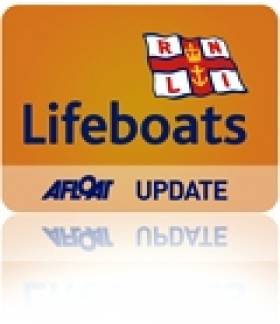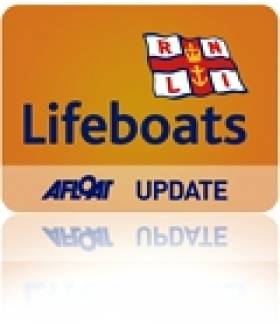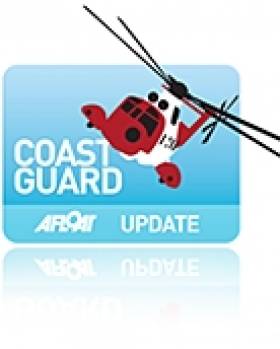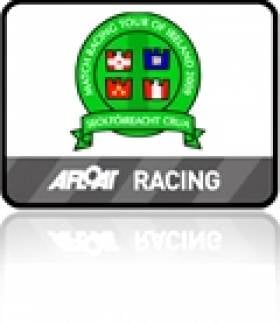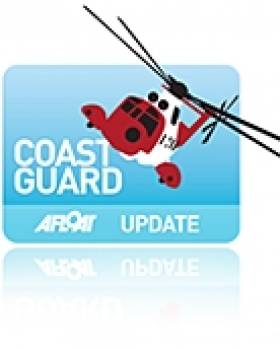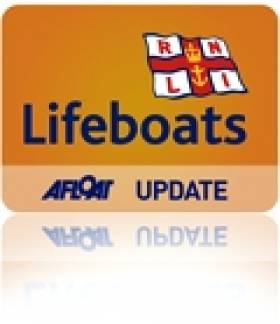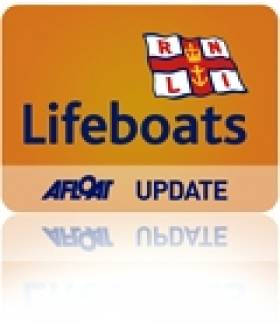Displaying items by tag: Bangor
Bangor Lifeboat Rescues Two Canoeists
Bangor Lifeboat launched at 11:40 am on Monday 24th January to rescue two canoeists from a stretch of water lying between the Copeland Island and Donaghadee known locally as the Donaghadee Sound. One of the canoeists had apparently entered the water and was in difficulty.
Belfast Coastguard requested RNLI Bangor Lifeboat to launch.
Within minutes of the rescue pagers being activated, Bangor volunteer crew had assembled and had launched the RNLI's fast response Atlantic 85 type lifeboat the 'Jessie Hillyard '.
With a top speed of 35 knots Bangor Lifeboat quickly arrived on scene.
The Fishery Protection vessel also received the rescue alert and was by minutes the first vessel on the scene. With the Fishery Protection vessel providing a weather lee, crew from Bangor Lifeboat quickly plucked the exhausted canoeist from the water. The second canoeist was then brought aboard Bangor Lifeboat along with both canoes.
Donaghadee Lifeboat who also launched to this rescue stood close by to offer additional medical support if required.
Bangor Lifeboat accompanied by Donaghadee Lifeboat returned to Donaghadee Harbour and both canoeists were landed safely ashore.
Ewan Scott, helmsman onboard Bangor Lifeboat praised the actions of both volunteer crews. He said 'The dedication and commitment of both Bangor and Donaghadee volunteer crews is evident in the professional manner in which they undertook this rescue' He added 'We're happy that both canoeists are now safely ashore.'
Related Safety posts
RNLI Lifeboats in Ireland
Safety News
Rescue News from RNLI Lifeboats in Ireland
Coast Guard News from Ireland
Water Safety News from Ireland
Marine Casualty Investigation Board News
Marine Warnings
RNLI Bangor Lifeboat launched to Assist Crab Fishing Boat
RNLI Bangor Lifeboat launched at 1:20 pm on Monday 17th January to assist 1 person aboard a 21ft crab fishing boat which had experienced gearbox mechanical failure close to shore.
Within minutes of the rescue pagers being activated, volunteer crew had launched RNLI Bangor Lifeboat and quickly located the crab fishing boat close to shore near Ballymacormick Point which is 1 ½ nautical miles north east of Bangor Harbour.
Calm weather conditions had allowed the skipper of the fishing vessel to make emergency repairs to the gearbox.
RNLI Bangor Lifeboat escorted the fishing vessel to the safety of Bangor Harbour and assisted the skipper with docking manoeuvres.
This is the first rescue call for RNLI Bangor Lifeboat in 2011.
Related Safety posts
RNLI Lifeboats in Ireland
Safety News
Rescue News from RNLI Lifeboats in Ireland
Coast Guard News from Ireland
Water Safety News from Ireland
Marine Casualty Investigation Board News
Marine Warnings
Cameron Dodges Issue of Bangor Closure
British Prime Minister has dismissed concerns over the potential loss of Northern Ireland's Coastguard centre.
The Belfast Telegraph reports that when questioned on the future of the Bangor control centre by DUP MP Jim Shannon, David Cameron replied that he understood "the need for good air sea rescue".
“I think what matters is not necessarily who is carrying it out, but are they fully qualified, is it a good service and is it value for money?” he added.
As previously reported on Afloat.ie, the Bangor Coastguard control centre is facing closure under reforms to the service across the UK announced by Shipping Minister Mike Penning.
Bid to Hold Women's Match Racing Event on Belfast Lough
In a further boost for the fledgling match racing scene here, top Irish international Umpire Bill O'Hara is looking to have the ISAF Grade one women's match racing event held on Belfast Lough from his home port of Bangor from August 17 - 20 2011, straight after the Weymouth pre-Olympic event.
Concern for RIB on Passage from Rathlin to Bangor
Concern for the occupants of the 8 metre RIB was initially raised when it was reported that it had left Rathlin harbour at 6.00pm in adverse weather conditions. Belfast Coastguard attempted to contact the vessel on VHF radio and mobile telephone but were unsuccessful.
Further enquiries yielded that the RIB was suspected to be heading to Bangor Harbour, and so Belfast Coastguard sent the Bangor Coastguard Rescue Team out to see if they could sight the vessel. In the meantime, Belfast Coastguard intercepted a communication from the RIB to Clyde Coastguard, whom they had contacted to inform them that they were just entering Bangor Harbour, in line with their passage plans.
In order to ensure they had safely arrived, Belfast Coastguard completed a radar search for the vessel and discovered that the occupants of the RIB were incorrect about their location, and had in fact just entered Belfast Lough, 13 miles from where they thought they were.
Belfast Coastguard finally managed to make communication with the RIB and ensured that they had sufficient fuel to complete their journey to Bangor. When the RIB arrived in Bangor they were met by the Bangor Coastguard Rescue Team who ensured they were safe and well and offered some safety advice.
Belfast Coastguard Watch Manager Alan Pritchard said:
"We became immediately concerned for the safety of the occupants of the RIB when we were informed that they were heading out in such poor weather conditions, and our worries increased when it became apparent that they had no idea of their position and began heading into the wrong port. The occupants of the RIB are now safely ashore and although were not in need of medical assistance they were quite badly shaken from the experience as it transpires that they had been trying to reach Bangor for several hours.
When we are informed of incidents such as these it allows the Coastguard to play a proactive role in preventing a situation from worsening by monitoring a vessel's passage. However, this could have all been prevented by the crew preparing for their journey, advising the Coastguard of their intentions and being aware of their own capabilities and weather conditions."
Fenit Name New Lifeboat in Memory of Bangor Couple
A brand new RNLI inshore lifeboat was officially named 'Bradley and Sonya' during a moving ceremony on Saturday 25th September at Fenit which is located on north side of Tralee Bay on the far south west coast of Ireland. The new D class lifeboat was named in memory of a young couple, Bradley and Sonya Burns from Bangor who were lifeboat volunteers and who died within 10 months of each other in 2006.
Volunteer lifeboat crew with Bangor RNLI raised £34027.48 to fund the lifeboat as a tribute to the young couple.The lifeboat was named by Mrs Mary Connolly and Mrs Eileen Savage, the mothers of Sonya and Bradley, while Sonya's sister Judy Connolly and Bangor lifeboats Senior Helmsman Kyle Marshall delivered the lifeboat into the care of Fenit RNLI. Fourteen members of Bangor lifeboat crew attended the ceremony along with members of the couple's family and lifeboat volunteers from around the coast.
Speaking during the ceremony Judy Connolly said, "Whilst we will never forget Bradley and my sister Sonya it is some comfort to know their legacy lives on, doing what they did so well – working to save lives at sea. We are delighted that this modern new lifeboat will make a real difference to the search and rescue capability in the Kerry area. Tragedy is never far from the sea and I do hope that it will be the instrument to save many lives."
Lifeboat Operations Manager with Fenit RNLI Gerard O'Donnell added, "We are extremely grateful to the crew at Bangor lifeboat station for their generosity in funding the new lifeboat. On behalf of the lifeboat crew in Fenit I offer our sincere thanks. This improved lifeboat will allow our volunteer crews to respond more quickly in emergencies and may well make the difference between life and death for someone in trouble in the water. "
Kyle Marshall, Senior Helmsman on Bangor lifeboat commented "It is a truly fitting honour and legacy to the memory of our dear friends Bradley and Sonya; they gave so much to the RNLI." Kyle went on to say "The generosity and support from the people of Bangor, from others further afield and from within the RNLI family has been overwhelming. So many individual people, groups and companies have selflessly given of their time, effort and money to fund this new Fenit lifeboat. We at RNLI Bangor Lifeboat wish to express our heartfelt thanks to everyone who made the funding of this new lifeboat possible"
The Bradley and Sonya lifeboat will join Fenit's all weather Trent class lifeboat Robert Hywell Jones Williams.
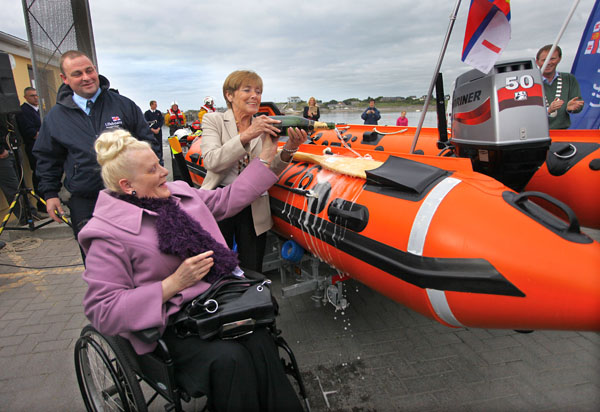
Mrs. Mary Connolly (Sonya's mother) and Mrs. Eileen Savage (Bradley's mother) name RNLI Fenit lifeboat 'Bradley and Sonya'
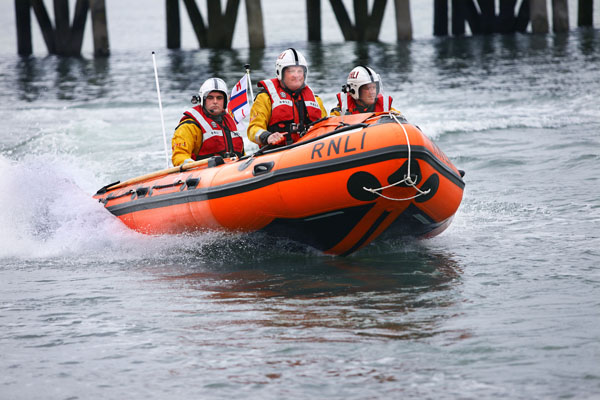
Fenit Lifeboat in action. The RNLI D class lifeboat is 5 metres in length and has a maximum speed of 25 knots. Photos: Valerie O'Sullivan
Related Safety posts
RNLI Lifeboats in Ireland
Safety News
Rescue News from RNLI Lifeboats in Ireland
Coast Guard News from Ireland
Water Safety News from Ireland
Marine Casualty Investigation Board News
Marine Warnings
Bangor Lifeboat Crew to Receive Freedom of the Borough
The Atlantic 85 type lifeboat. the Jessie Hillyard. based in Bangor Harbour has two Yamaha 4-stroke engines giving a top speed of 35 knots. It features state of the art radar, chart plotter VHF radio and radio direction finding technology to enhance its lifesaving capabilities. Volunteer crew at Bangor take pride in a launch time of under four minutes from when their rescue pagers are activated.
Everyone connected with RNLI Bangor Lifeboat - the crew, station management, fundraisers and helpers - are all volunteers, giving freely of their time, braving all weathers, 24 hours a day, 365 days a year to help save life at sea.
Bangor's Lifeboat Operations Manager Kevin Byers also a volunteer is looking forward to receiving North Down Borough Councils highest award honouring the work of RNLI Bangor Lifeboat. He said
'We wish to publicly thank North Down Borough Council for their continued support and for honouring RNLI Bangor Lifeboat with this prestigious award' he added.
'It is a truly fitting tribute to the huge commitment and dedication of the Bangor volunteer crew and station personnel both past and present who have devoted so much of their time and effort to lifesaving at sea'
Related Safety posts
RNLI Lifeboats in Ireland
Safety News
Rescue News from RNLI Lifeboats in Ireland
Coast Guard News from Ireland
Water Safety News from Ireland
Marine Casualty Investigation Board News
Marine Warnings


























